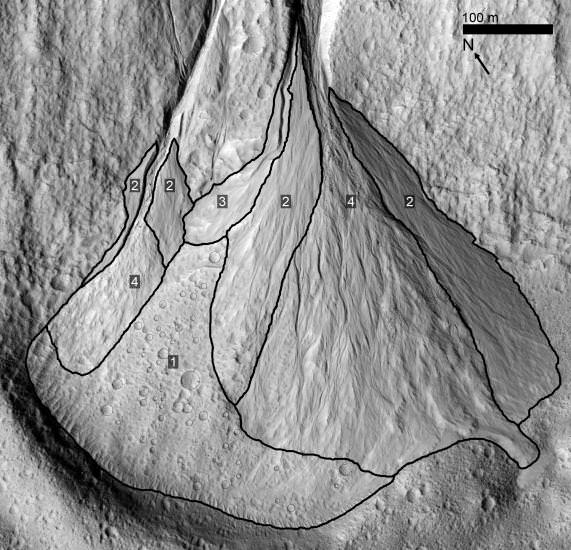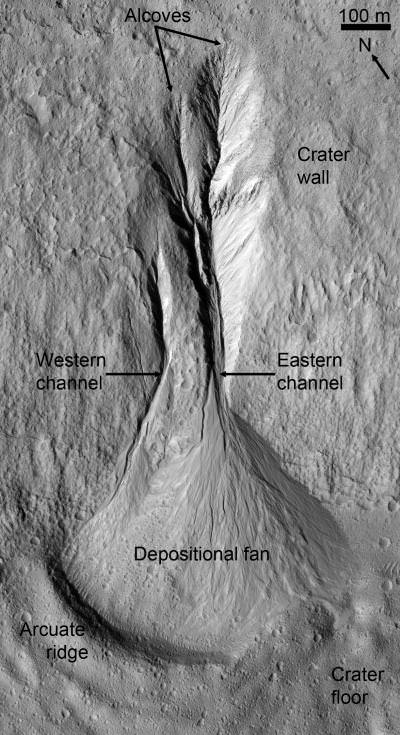[/caption]
A new study of gullies seen on Mars provides evidence that water flowed recently on the Red Planet, at least in geologic terms. Planetary geologists at Brown University have found a gully fan system on Mars that formed only about 1.25 million years ago. The structure of this fan offers compelling evidence that it was formed by melt water that originated in nearby snow and ice deposits. This time frame may be the most recent period when water flowed on the planet. This most recent finding comes on the heels of discoveries of water-bearing minerals such as opals and carbonates, and together all these discoveries provide clues that Mars was, at least occasionally, wetter and warmer for far longer than previously thought.
While gullies are known to be young surface features, it’s difficult to date them. But the Brown scientists were able to date the gully system because of craters in the area, and also hypothesize what water was doing there.
The gully system shows four intervals where water-borne sediments were carried down the steep slopes of nearby alcoves and deposited in alluvial fans, said Samuel Schon, a Brown graduate student and the paper’s lead author.
“You never end up with a pond that you can put goldfish in,” Schon said, “but you have transient melt water. You had ice that typically sublimates. But in these instances it melted, transported, and deposited sediment in the fan. It didn’t last long, but it happened.”

The gully system is located on the inside of a crater in Promethei Terra, an area of cratered highlands in the southern mid-latitudes. The eastern and western channels of the gully each run less than a kilometer from their alcove sources to the fan deposit.
Viewed from afar, the fan appears as one entity several hundred meters wide. But by zooming in with the HiRISE camera aboard the Mars Reconnaissance Orbiter, Schon was able to distinguish four individual lobes in the fan, and determine that each lobe was deposited separately. Moreover, Schon was able to identify the oldest lobe, because it was pockmarked with small craters, while the other lobes were unblemished, meaning they had to be younger.
Next came the task of trying to date the secondary craters in the fan. Schon linked the craters on the oldest lobe to a rayed crater more than 80 kilometers to the southwest. Using well-established techniques, Schon dated the rayed crater at about 1.25 million years, and so established a maximum age for the younger, superimposed lobes of the fan.
The team determined that ice and snow deposits formed in the alcoves at a time when Mars had a high obliquity (its most recent ice age) and ice was accumulating in the mid-latitude regions. Sometime around a half-million years ago, the planet’s obliquity changed, and the ice in the mid-latitudes began to melt or, in most instances, changed directly to vapor. Mars has been in a low-obliquity cycle ever since, which explains why no exposed ice has been found beyond the poles.
The team tested other theories of what the water may have been doing in the gully system. The scientists ruled out groundwater bubbling to the surface, Schon said, because it seemed unlikely to have occurred multiple times in the planet’s recent history. They also don’t think the gullies were formed by dry mass wasting, a process by which a slope fails as in a rockslide. The best explanation, Schon said, was the melting of snow and ice deposits that created “modest” flows and formed the fan.
The team’s findings appear in the March issue of Geology.
Source: Brown University


herea a crazy thougt. maybe something happend that made mars loose its atmosfere. maybe it was the same thing that killed. all the dinosaurs. could the sun have made some kind of killer flare maybe.
@Kenn hammer: While INAA, I think the current explanation for the loss of Mars’s atmosphere is due to its lack of a magnetosphere, allowing solar wind to gradually blow off the atmosphere; prolly due to its core cooling and solidifying. Any solar flare big enough to strip the majority of a planets atmosphere away would have to be of improbable size…and there would be plenty of evience of such a flare on other ( prolly most ) objects in the solar system. I doubt Earths magnetosphere would be powerful ebnough to protect against a flare of that magnitude. Whereas for what killed the ‘saurs on Earth was prolly due to an asteroid or similar impact, based upon crater evidence etc.
theres lot of teories about what killed the dinosaurs. but we will never know. unless wee solve the universal puzzle and build a time machine :). but i guess maybe u are right about mars core cooling down. but who knows right. there still a lot of things we dont know
Mars has a thin atmosphere and little water because the planet does not have enough mass for it’s gravity to keep hydrogen and other gases from escaping to space.
Earth loses hydrogen and helium to space for the same reason, but at a much slower rate.
“They also don’t think the gullies were formed by dry mass wasting, a process by which a slope fails as in a rockslide.”
I find a possible fault in this argument. Two facts come to mind. First off, if you look at the early images from the Mars rover Spirit and note where the airbags were dragged across the surface when deflated, the modified surface material kind of looks like it is made out of chocolate pudding or ‘taffy’ and appears very viscose in its flow patterns. Secondly, given Mars gravity and surface pressure, dry mass wasting will appear quite differently than here on Earth. Thirdly, consider the trouble found getting the ‘loose’ surface material collected by the robot digging arm into the sample trays on the Phoenix lander. That soil apparently had to ‘melt’ or evaporate somewhat before it became loose enough to go thru the screens, but eventually it did. Liquid water on the surface of Mars? I don’t think so. Instead, try a viscose mixture of very fine dust and perchlorate flowing in suspension during a warmer period of Mars history, say during a planetary dust storm or extreme polar tilt..
Calib is correct, the atmosphere of Mars has no protection from the solar wind. We have actually detected the faint traces of the atmosphere of Mars trailing behind it in orbit, being blown off even as we speak.
What amazes me about the photos we have seen is that everyone has been on the “millions of years” band wagon for so long they are having trouble getting off of it. It has been “Mars had water millions of years ago” “Mars was geologically active millions of years ago”
With observations that actually update every few hours or days instead of decades we are going to find that Mars is quite alive indeed. We will see both glacial activity that takes a few years, as well as landslides of complex salt-saturated wash.
~]3
The current “popular” theory on the lack of atmosphere on Mars is due to its mass.
Venus also lacks a complicated magnetic field, yet has a very thick atmosphere and is affected a great deal more by solar wind.
Try this: In modern times several planetwide dust storms have been observed on Mars. During those periods huge amounts of dust are lofted into the Martian atmosphere. Held in suspension those particles may act as a thermal absorption blanket collecting solar radiation and thereby raising surface temperatures to unknown levels. It may be that during these episodic events temperatures become high enough to ‘liquify’ surface particulates while promoting atmospheric mixing. Given recently discovered perchlorate concentrations in the soil, liquifaction might cause them to flow or act as liquids. What I am sugesting is that during planetwide dust storms Martian meterology can assume the characteristics of a much denser atmosphere.
The other day, a gentleman mentioned in this blog that if we were to find life on a planet or moon in our Solar System, it would be another step toward disproving religion/God. I just want to say that I’m a scientific freak. But, I’m also a Jesus freak. I dont believe that finding life elsewhere disproves God at all. It would only further enhance the mystery of where life began in the Universe. Man thinks that through science… all can be proven. That is wrong. Science has brought about more questions and mysteries as we get smarter. We are no closer to figuring out where it all began than we were a thousand years ago. We only know more about the cosmos. God will reveal Himself in due time. Man should not become so vain in the notion that sending probes into outerspace will disprove that a God started it all. Nothing from nothing leaves nothing. And something intelligent started it all.
Amen George.
It’s “obvious” that Venus has a thick atmosphere because it has a lot more mass than Mars does.
I wonder what a Martian opal would sell for here on Earth?
Venus is slightly less massive than Earth, but its atmosphere is 90 times the mass of Earth’s atmosphere. Thus there is not a direct or obvious correlation between a rocky planet’s mass and its atmosphere’s mass.
I don’t buy the water argument for a minute. The “gullies” and related phenomena simply do not bear the mark of flowing water. For instance, the narrow neck in the middle of the area from which matter has been expelled and the area where is has been deposited is not consistent with a water event.